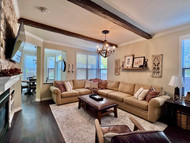
If you’ve been planning a DIY project in your home — and you intend on using faux beams — you’re probably already aware of the benefits. Exposed ceiling beams are an element that can substantially elevate your home’s look and feel. Growing in popularity as a home design feature, wood beams are suitable for many different spaces and styles.
Deciding how far apart to space your beams might feel overwhelming. But trust us, there is no wrong answer! To help you plan out your ceiling beam DIY, we’ve written this guide to help you through the process.
4 Faux Beam Spacing Considerations
In general, closer spacing will make the ceiling feel lower and cozier, while beams installed further apart make the ceiling feel higher and more elegant. Beam spacing is typically between two and eight feet apart, while the most common ceiling beam spacing is four feet apart.
In reality, there is no wrong answer. Beam spacing is a matter of personal preference!
For results you’ll love, consider these four factors when deciding how far apart to space your beams.
1. Width of Your Wood Beams
Determining how far apart to space faux wood beams is primarily influenced by the width of your beams. Because they are larger, wider and/or thicker beams look better with more space between them, while thinner beams may need less space to feel complete.
2. Size of the Room
Whether you’re installing faux wood beams in a bedroom, living space, kitchen, or dining room, the size of the room has an impact on the spacing of your beams. The smaller the room, the more space you may want to leave between the beams so that the ceiling doesn't feel too low and restricting.
3. Desired Design & Installation Approach
Whether you install your first and last beams right up against the wall or start them some distance away, this could have an impact on how far apart to space your faux beams.


Ceiling Beams Against Your Walls: Place your first and last beams right up against the wall on each side of the ceiling to create a tidy, enclosed effect. With this installation approach, the beam butts up against a wall, leaving only two visible sides, so you can save money by ordering L-headers that match your other beams.
Ceiling Beams Away From Your Walls: Place your first and last beams some distance away from your walls to create a more expansive look. You can plan equal spacing between the walls and each one of your beams, or have a shorter distance between the walls and your first and last beams.
4. Visualize the End Result
If your ceiling is low enough, mark where the beams will be with painter’s tape to visualize how your project will look. If you don’t love the spacing, pull the tape down and try again.
One of the best ways to picture how your beam spacing will turn out is to browse photos of previous projects. You can find design inspiration in several different room styles on our website.
Ordering Ceiling Beams
Once you’ve decided how far apart to space your faux wood beams, and where you want to install your first and last beams, you’ll want to order the appropriate number and dimensions of beams.
Taking into account the width of the room, calculate how many ceiling beams it will take to create your design while maintaining your desired spacing. Be sure to factor in whether you want a beam to be flush with the wall, or if you want there to be spacing between the first beam and the wall.
After you’ve received your beams and you’re ready to install, follow our detailed DIY faux beam installation instructions.
How Faux Beams Are Different from Solid Wood
Faux wood beams can help you achieve the look of real wood, and they have some clear benefits over the real thing.
Faux beams are made from durable high-density polyurethane and are extremely lightweight in comparison to real wood. A 6" x 6" x 10’ faux beam weighs under 20 pounds, whereas solid wood would weigh 600 pounds!
The light weight of faux beams makes installation DIY-friendly, and a much more affordable project overall. And, faux beams don’t put additional strain on your home’s frame, so they’re safer to use and less likely to cause damage or require maintenance.
Creating Your Dream Faux Beam Design

There are several aspects to accomplishing your wood beam project. In addition to determining faux beam spacing, you will need to carefully select the color and style of the beams you want to install.
At AZ Faux, we have an array of faux wood beams in many textures and finishes. Interested in painting your beams for a truly unique look? All of our faux beams are available unfinished so your possibilities are endless!
In need of more inspiration?
Get started now by browsing our faux beam collections.